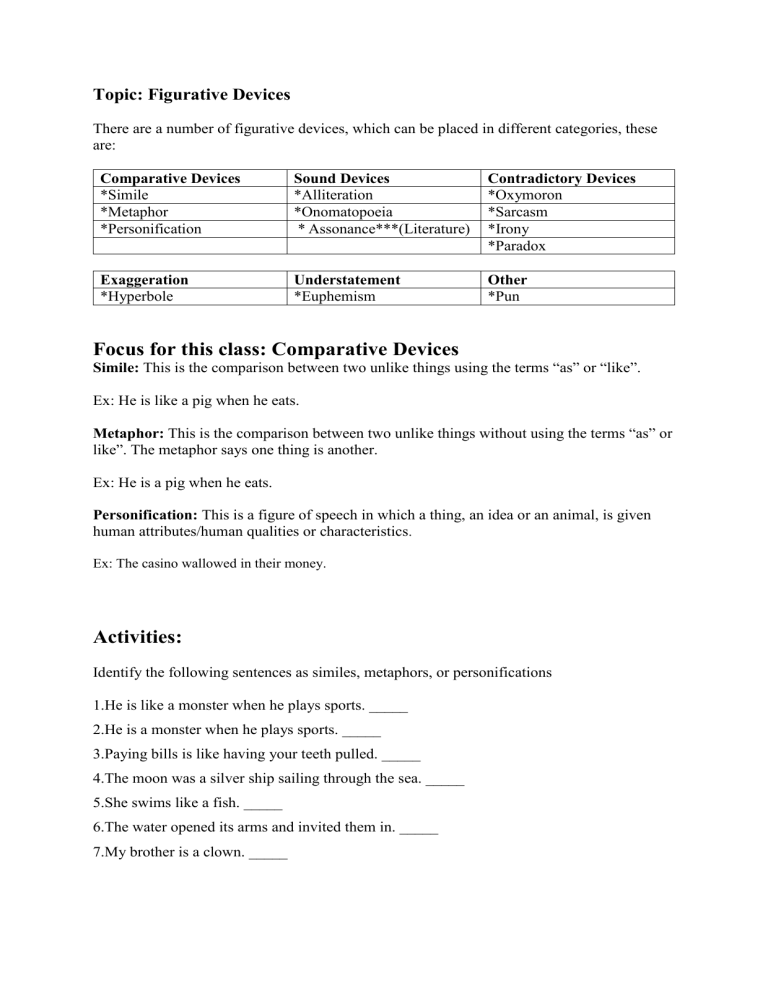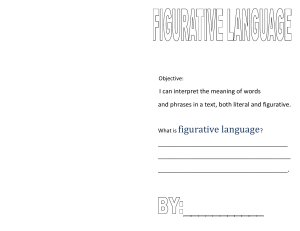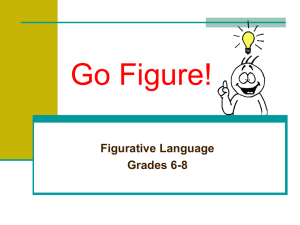
Topic: Figurative Devices There are a number of figurative devices, which can be placed in different categories, these are: Comparative Devices *Simile *Metaphor *Personification Sound Devices *Alliteration *Onomatopoeia * Assonance***(Literature) Contradictory Devices *Oxymoron *Sarcasm *Irony *Paradox Exaggeration *Hyperbole Understatement *Euphemism Other *Pun Focus for this class: Comparative Devices Simile: This is the comparison between two unlike things using the terms “as” or “like”. Ex: He is like a pig when he eats. Metaphor: This is the comparison between two unlike things without using the terms “as” or like”. The metaphor says one thing is another. Ex: He is a pig when he eats. Personification: This is a figure of speech in which a thing, an idea or an animal, is given human attributes/human qualities or characteristics. Ex: The casino wallowed in their money. Activities: Identify the following sentences as similes, metaphors, or personifications 1.He is like a monster when he plays sports. _____ 2.He is a monster when he plays sports. _____ 3.Paying bills is like having your teeth pulled. _____ 4.The moon was a silver ship sailing through the sea. _____ 5.She swims like a fish. _____ 6.The water opened its arms and invited them in. _____ 7.My brother is a clown. _____ 8.The rain kissed my face as it fell. _____ 9.The strawberries were yelling, “Eat me first!” _____ 10.He is a rabbit lost in the woods. _____ 11.Her glasses look like small bottle caps. _____ 12.His eyes are shining stars in the middle of the night. _____ 13.The car engine coughed and cried when it started during the cold winter morning. _____ Personification The delicious smell of cookies pulled me into the kitchen. "Follow Me". For each sentence, circle the object being personified and underline the human quality being given. 1.The wind sang her mournful song through the falling leaves. 2.The microwave timer told me it was time to eat my TV dinner. 3.The china danced on the shelves during the earthquake. 4.The rain kissed my cheeks as it fell. 5.The daffodils nodded their yellow heads at the walkers. 6.The snow whispered as it fell to the ground during the early morning hours. Personify the following sentences. Change the words in parentheses to words that would describe a human’s actions. 1. The puppy (barked) when I left for school. 2. The leaf (fell) from the tree. 3. The CD player (made a noise). 4. The arrow (moves) across the screen. 5. The net (moves) when the basketball goes through. Effectiveness of Devices: Using figurative language is an effective way of communicating an idea that is not easily understood because of its abstract nature or complexity. Although figurative language does not offer a literal explanation, it can be used to compare one idea to a second idea to make the first idea easier to visualize. Mother to Son By: Langston Hughes Well, son, I’ll tell you: Life for me ain’t been no crystal stair. It’s had tacks in it, And splinters, And boards torn up, And places with no carpet on the floor— Bare. But all the time I’se been a-climbin’ on, And reachin’ landin’s, And turnin’ corners, And sometimes goin’ in the dark Where there ain’t been no light. So boy, don’t you turn back. Don’t you set down on the steps ’Cause you finds it’s kinder hard. Don’t you fall now— For I’se still goin’, honey, I’se still climbin’, And life for me ain’t been no crystal stair Response 1. Write a brief summary of what you understand from the poem. 2. Identify the figurative device(s) being used in the poem and say how these devices help you to better understand the poem.




